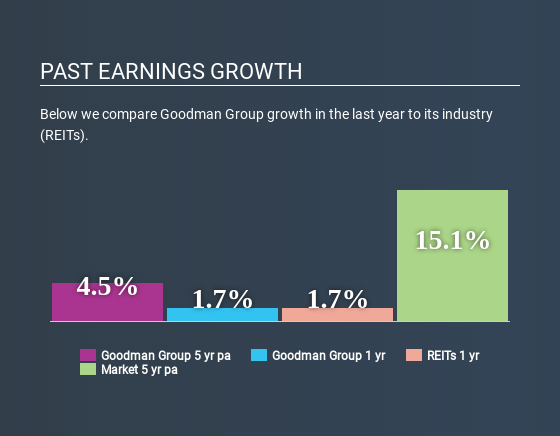Goodman Group's (ASX:GMG) Stock On An Uptrend: Could Fundamentals Be Driving The Momentum?

Most readers would already be aware that Goodman Group's (ASX:GMG) stock increased significantly by 20% over the past month. As most would know, fundamentals are what usually guide market price movements over the long-term, so we decided to look at the company's key financial indicators today to determine if they have any role to play in the recent price movement. Specifically, we decided to study Goodman Group's ROE in this article.
Return on equity or ROE is a key measure used to assess how efficiently a company's management is utilizing the company's capital. In other words, it is a profitability ratio which measures the rate of return on the capital provided by the company's shareholders.
See our latest analysis for Goodman Group
How Is ROE Calculated?
The formula for ROE is:
Return on Equity = Net Profit (from continuing operations) ÷ Shareholders' Equity
So, based on the above formula, the ROE for Goodman Group is:
14% = AU$1.5b ÷ AU$11b (Based on the trailing twelve months to December 2019).
The 'return' is the amount earned after tax over the last twelve months. So, this means that for every A$1 of its shareholder's investments, the company generates a profit of A$0.14.
What Has ROE Got To Do With Earnings Growth?
So far, we've learnt that ROE is a measure of a company's profitability. Depending on how much of these profits the company reinvests or "retains", and how effectively it does so, we are then able to assess a company’s earnings growth potential. Assuming all else is equal, companies that have both a higher return on equity and higher profit retention are usually the ones that have a higher growth rate when compared to companies that don't have the same features.
Goodman Group's Earnings Growth And 14% ROE
At first glance, Goodman Group seems to have a decent ROE. Further, the company's ROE compares quite favorably to the industry average of 8.0%. Despite this, Goodman Group's five year net income growth was quite low averaging at only 4.5%. This is generally not the case as when a company has a high rate of return it should usually also have a high earnings growth rate. Such a scenario is likely to take place when a company pays out a huge portion of its earnings as dividends, or is faced with competitive pressures.
Next, on comparing with the industry net income growth, we found that Goodman Group's reported growth was lower than the industry growth of 7.9% in the same period, which is not something we like to see.
Earnings growth is a huge factor in stock valuation. The investor should try to establish if the expected growth or decline in earnings, whichever the case may be, is priced in. This then helps them determine if the stock is placed for a bright or bleak future. Is GMG fairly valued? This infographic on the company's intrinsic value has everything you need to know.
Is Goodman Group Making Efficient Use Of Its Profits?
Goodman Group seems to be paying out most of its income as dividends judging by its three-year median payout ratio of 58% (or a retention ratio of 42%). However, this is typical for REITs as they are often required by law to distribute most of their earnings. Accordingly, this suggests that the company's earnings growth was lower as a result of the high payout.
Moreover, Goodman Group has been paying dividends for at least ten years or more suggesting that management must have perceived that the shareholders prefer dividends over earnings growth. Upon studying the latest analysts' consensus data, we found that the company's future payout ratio is expected to drop to 0.03% over the next three years. Still forecasts suggest that Goodman Group's future ROE will drop to 10% even though the the company's payout ratio is expected to decrease. This suggests that there could be other factors could driving the anticipated decline in the company's ROE.
Summary
In total, it does look like Goodman Group has some positive aspects to its business. Yet, the low earnings growth is a bit concerning, especially given that the company has a high rate of return. Investors could have benefitted from the high ROE, had the company been reinvesting more of its earnings. As discussed earlier, the company is retaining a small portion of its profits. That being so, a study of the latest analyst forecasts show that the company is expected to see a slowdown in its future earnings growth. Are these analysts expectations based on the broad expectations for the industry, or on the company's fundamentals? Click here to be taken to our analyst's forecasts page for the company.
If you spot an error that warrants correction, please contact the editor at editorial-team@simplywallst.com. This article by Simply Wall St is general in nature. It does not constitute a recommendation to buy or sell any stock, and does not take account of your objectives, or your financial situation. Simply Wall St has no position in the stocks mentioned.
We aim to bring you long-term focused research analysis driven by fundamental data. Note that our analysis may not factor in the latest price-sensitive company announcements or qualitative material. Thank you for reading.

 Yahoo Finance
Yahoo Finance 
